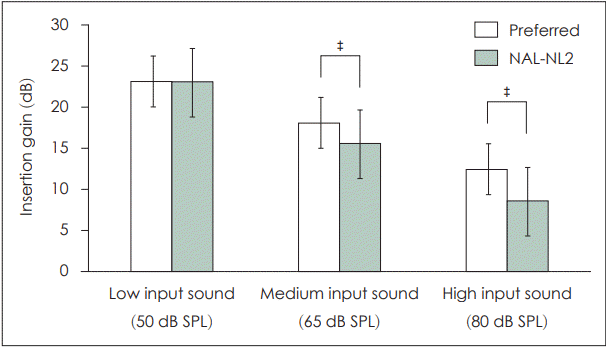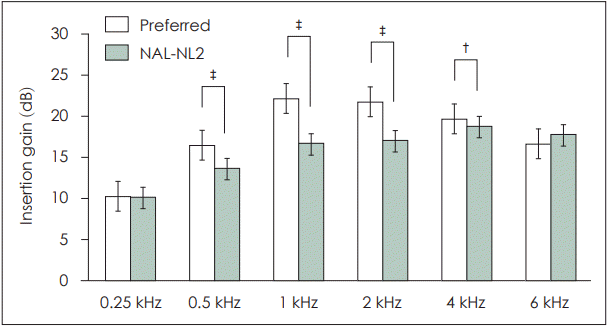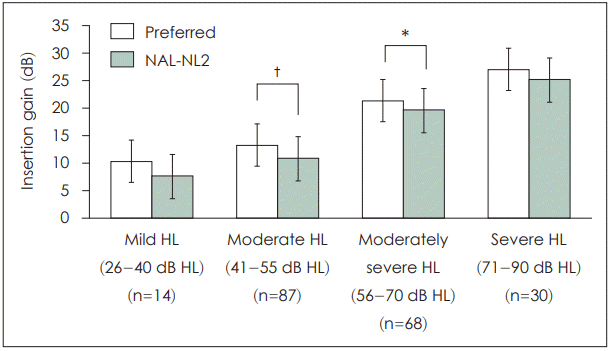Abstract
Background and Objectives
The purpose of this study was to compare the preferred gain and the National Acoustic Laboratories Nonlinear 2nd edition (NAL-NL2) gain value in Korean language hearing aid users.
Subjects and Method
In this retrospective study, preferred gain and NAL-NL2 gain data were obtained from 199 monaural hearing aids users who were satisfied with their hearing aid devices. The gain value data were collected from three different sound levels at various frequencies. Several factors were also evaluated to determine a potential impact on the preferred gain.
Hearing aids amplify the input signal to compensate for the increased hearing threshold of the hearing loss (HL) patient. The principle of fitting a hearing aid is that the amplified sound should be comfortably heard by the HL patient, and the intelligibility should be increased during conversation. The volume of the amplified sound should be adjusted so that it does not exceed the uncomfortable level [1,2].
A prescription fitting formula is used to achieve appropriate amplification through certain gain value. Most of the current initial hearing aid fittings for adults are based on the National Acoustic Laboratories Nonlinear 2nd edition (NAL-NL2) formula, a revised version of NAL-NL1 which was developed based on English [3]. After the initial fitting process, the fine-tuning procedure is performed based on the individual’s preference. The final satisfied level of hearing aid amplification is considered as the preferred gain [4]. Although fine-tuning may effectively satisfy hearing aid users, the appropriate initial fitting through fitting formula is important [5].
Adults with mild and moderate HL preferred less overall gain of 3 dB than NAL-NL1 formula in a medium input sound level [4,6]. The NAL-NL2 prescribes more gain in low and high frequencies and less gain in medium frequencies than NAL-NL1 [3]. A study reported at 65 dB and 80 dB SPL, 63% and 50% of participants preferred gain were within 5 dB of the NAL-NL2 prescribed target [7]. However, there is no previous study done on Korean language hearing aid users. The purpose of this study was to investigate the difference between the target gain based on the NAL-NL2 formula and the preferred gain among Korean hearing aid users in South Korea.
Data were collected between March 2016 and April 2019, 199 monaural hearing aid users from a tertiary health care center in Korea. The participants in the study were first-time hearing aid users with sensorineural HL who were satisfied with their hearing aid for 6 months or more. The preferred gain values were compared with the target gain values based on the NAL-NL2 prescriptive method. This study was performed in accordance with the Helsinki Declaration. The Institutional Review Board approved this study (IRB No. 2021GR0320). The informed consent was waived because this study design is retrospective medical record analysis.
Based on the patient’s pure tone audiometry results, the initial setting was done with Target 4.1 (Phonak, Zurich, Switzerland) and Smart Fit 1.4 (ReSound, Ballerup, Denmark) 1.4 programs which were developed based on NAL-NL2 formula. The fine-tuning procedure was usually performed one to two weeks after the initial setting was established. Participants were allowed to undergo the fine-tuning process repeatedly to obtain the most satisfactory sound level for optimum hearing ability. The experienced staff adjusted the gain value in a quiet, controlled room based on the patient’s subjective satisfaction within their company’s protocol. To achieve a stable level of gain, all the preferred gain values were collected 6 months after initiating the fine-tuning process. The patient’s subjective satisfaction was subsequently assessed through the Abbreviate Profile of Hearing Aid Benefit, 66 item self-assessment, disability-based inventory that is used to document the outcome of a hearing aid fitting [8].
The NAL-NL2 targets prescribe for the input levels of 50, 65, and 80 dB SPL. The data of the gain values were collected when low (50 dB), medium (65 dB), and high (80 dB) input sound levels were administered with low to high frequencies (0.25, 0.5, 1, 2, 4, 8 kHz). Additional data that were collected including age, sex, type of hearing aid, and degree of HL of the hearing aid users. The degree of HL was categorized as mild HL (26-40 dB), moderate HL (41-55 dB), moderately severe HL (56-70 dB), severe HL (71-90 dB), and profound HL (91 dB or more). The three types of hearing aids used by the participants were behind the ear (BTE), receiver in the canal (RIC), and customized type. The customized group included two types of hearing aids: in the ear and completely in canal.
Exclusion criteria were as follows: less than 10 years of age or more than 90 years of age, profound HL, and history of infectious disease or middle ear surgery.
A paired t-test was used to compare preferred gain and NAL-NL2 gain. The difference according to hearing aid type was compared using the analysis of variance (ANOVA) t-test. An ANOVA trend analysis was performed to investigate a potential relationship in age. The results were analyzed by IBM SPSS version 20 (IBM Corp., Armonk, NY, USA), and a p-value of 0.05 or less was considered significant.
A total of 199 hearing aid users were enrolled in this study. In age distribution, most patients were over 60 years of age (n=142, 71.3%). There was a greater proportion of female participants enrolled in the study (n=116, 58.3%). For the degree of HL, most participants belonged to the moderate (n=87, 43.7%) and moderately severe (n=68, 34.2%) groups. The RIC (n=111, 55.8%) was the most used hearing aid type among the participants, followed by the customized type (n=79, 39.7%), and BTE (n=9, 4.5%) (Table 1).
The average preferred gain (17.8±11.7 dB) was higher than the NAL-NL2 gain (15.6±10.4 dB) by 2.2±6.6 dB (95% confidence interval [CI]: 1.30-3.16, p<0.001). According to the input sound level, the difference was significant in the high-level (3.9±7.2 dB, 95% CI: 2.89-4.91, p<0.001) and medium-level (2.6±7.04 dB, 95% CI: 1.63-3.60, p<0.001) input sound (Fig. 1). In the frequency response, the preferred gain was statistically higher in all frequencies, except 0.25 kHz and 6 kHz. The difference was largest at 1 kHz (5.6±10.0 dB, 95% CI: 4.78-6.39, p< 0.001) followed by 2 kHz (4.7±8.2 dB, 95% CI: 4.094-5.38, p<0.001), 0.5 kHz (2.9±8.2 dB, 95% CI: 2.24-3.56, p<0.001), and 4 kHz (1.0±0.3 dB, 95% CI: 0.25-1.66, p<0.01) (Fig. 2).
Based on the degree of HL, there was a significant difference between preferred gain and NAL-NL2 gain in moderate HL (2.6± 0.57 dB, 95% CI: 1.42-3.68, p<0.01) and moderately severe HL (1.8±0.73 dB, 95% CI: 0.41-3.32, p<0.05) (Fig. 3).
To investigate the age factor, participants were divided into 60 years old-age group. The pre-existing degree of HL in both groups was not statistically different (58.4 dB vs. 56.2 dB, p=0.266). The group of younger participants (20.2±14.0 dB) demanded more gain than the group of older participants (16.9±10.6 dB). In ANOVA trend analysis, there was a tendency of reduced preferred gain with increased age (p=0.049).
There were three types of hearing aids: RIC (n=111), customized type (n=79), and BTE (n=9). The pre-existing degree of HL was highest in participants with the BTE type of hearing aid (BTE [62.3 dB], customized type [60.0 dB], RIC [54.2 dB]; ANOVA t-test, p<0.001). Since the number of BTE was only 9, which is few to classify into one group, the analysis was conducted by integrating with the RIC. The preferred gain of BTE and RIC group was 16.8±13.27 dB and the preferred gain of the customized type group was 20.8±12.25 dB, and the difference was significant (3.91±1.87 dB, 95% CI: -7.8--0.25, p=0.036).
The preferred gain in Korean hearing aid users was significantly higher than the NAL-NL2 gain. This result implies that the target gain based on the NAL-NL2 fitting formula should be increased to reflect this preference among Korean hearing aid users.
The NAL-NL2 formula was invented based on an English-speaking population. The NAL-NL2 also considered language for prescription. For example, tonal languages like Chinese, slightly more low-frequency is prescribed [3].
Linguistic or acoustic differences between the Korean and English languages may help explain the results obtained in our study. Indeed, a review of the literature confirms the linguistic or acoustic differences between the two languages.
The long-term average speech spectrum (LTSS) shows the average frequency distribution of sound energy in continuous speech. It is used for the evaluation of the hearing instrument’s suitability or fitting of hearing aid [9]. In a comparison study of the LTSS of Korean monosyllabic words and sentences and English sentences, there was a significant difference at frequencies of 125, 160, 500, and 4000 Hz (p<0.05), but not in other frequencies [10]. The dynamic range (DR) of speech refers to the difference between the minimum and maximum speech levels. The DR for the Korean language was lower than that for the English language at low-frequency bands but larger at mid-frequency bands [11]. The band-importance function (BIF) relates to a value characterizing the relative importance of various frequencies to speech intelligibility [12]. The low-frequency regions below 1 kHz were more important in the Korean language than in the English language [13]. However, it is not yet clear exactly how much these differences affect the preferred gain. The preferred gain was higher than the NAL-NL2 gain at most frequencies except 6 kHz in our study, which is not consistent with previous studies regarding linguistic differences. Further research is needed on the relationship between preferred gains according to differences in LTSS, DR, and BIF.
The tendency for higher gain was found in the group of younger participants. A similar result was found in a previous study, specifically that the group of younger participants preferred greater gain; however, it was not significant (p=0.08) [14]. Another study found that children preferred higher gain levels than adults [15]. Age-related emotional, physical, physiological differences may affect the result, but further study is needed.
There were some limitations in this study. The real ear measurements were not performed, and the fine-tuning process followed company’s own protocol which could be subjective. Though real ear measurements for fine-tuning of hearing aids were not performed in all cases, the satisfaction of enrolled hearing aid users was proven over the long term through improvement in Abbreviate Profile of Hearing Aid Benefit [8]. The difference due to real ear measurement would have been small since the patient with ear canal deformity, surgical history, and pediatrics were excluded. Even if the fine-tuning process was subjective, it is meaningful because the preferred gain was obtained from the subjectively satisfactory value of the hearing aid users for more than 6 months. Only the monaural hearing aids were analyzed in this study. It is well-known that the binaural loudness summation concept may influence an individual’s hearing threshold. Due to binaural summation, the difference in decibels in monoaural hearing aid users is 3-5 dB [16]. For this reason, in NAL-NL2 fitting formula, the monoaural and binaural prescription targets are different. Therefore, the difference between the preferred gain and the NAL-NL2 gain is not due to the monoaural hearing aid. Another limitation is that three types of hearing aids were used. The output power of the hearing aid depends on the characteristics of the hearing aid itself. However, this would not influence the results, because the difference was only determined by the output gain of each hearing aid.
In conclusion, this study analyzed the difference between actual preferred gain and gain value based on the NAL-NL2 formula in Korean hearing aid users. On average, the preferred gain showed a higher gain level than the NAL-NL2 gain. The difference was statistically significant in moderate and moderately severe HL hearing aid users. In the medium or high input level of sound, the gain value should be increased more than the gain based on the NAL-NL2 formula. In terms of frequencies, the higher gain should be administered than the gain obtained from the NAL-NL2 formula in all frequencies except 0.25 and 6 kHz.
Notes
Author Contribution
Conceptualization: Sung-Won Chae. Data curation: Sung-Won Chae. Formal analysis: Jong-Geun Lee. Investigation: Jong-Geun Lee. Methodology: Jae-Jun Song. Project administration: Sung-Won Chae. Resources: Sung-Won Chae. Software: Jae-Min Jeon. Supervision: Sung-Won Chae. Validation: Jae-Min Jeon. Visualization: Jae-Jun Song. Writing—original draft: Jong-Geun Lee. Writing—review & editing: Jong-Geun Lee.
REFERENCES
1. Byrne D, Dillon H, Ching T, Katsch R, Keidser G. NAL-NL1 procedure for fitting nonlinear hearing aids: Characteristics and comparisons with other procedures. J Am Acad Audiol. 2001; 12(1):37–51.
2. Ching TY, Dillon H, Katsch R, Byrne D. Maximizing effective audibility in hearing aid fitting. Ear Hear. 2001; 22(3):212–24.
3. Keidser G, Dillon H, Flax M, Ching T, Brewer S. The NAL-NL2 prescription procedure. Audiol Res. 2011; 1(1):e24.
4. Keidser G, O’Brien A, Carter L, McLelland M, Yeend I. Variation in preferred gain with experience for hearing-aid users. Int J Audiol. 2008; 47(10):621–35.
5. Mueller HG, Hawkins DB, Northern JL. Probe microphone measurements: Hearing aid selection and assessment. San Diego: Singular;1992.
6. Boymans M, Dreschler WA. Audiologist-driven versus patient-driven fine tuning of hearing instruments. Trends Amplif. 2012; 16(1):49–58.
7. English R, Plant K, Maciejcz yk M, Cowan R. Fit ti ng recommendations and clinical benefit associated with use of the NAL-NL2 hearing-aid prescription in nucleus cochlear implant recipients. Int J Audiol. 2016; 55 Suppl 2(1):S45–50.
8. Cox RM, Alexander GC. The abbreviated profile of hearing aid benefit. Ear Hear. 1995; 16(2):176–86.
9. Pavlovic CV. Speech spectrum considerations and speech intelligibility predictions in hearing aid evaluations. J Speech Hear Disord. 1989; 54(1):3–8.
10. Jin IK, Lee JH. A comparison of long-term average speech spectrum (LTASS) among Korean monosllyabic words, sentences, and English sentences. Audiology. 2010; 6(2):164–72.
11. Jin IK, Kates JM, Arehart KH. Dynamic range for speech materials in Korean, English, and Mandarin: A cross-language comparison. J Speech Lang Hear Res. 2014; 57(5):2024–30.
12. Bosen AK, Chatterjee M. Band importance functions of listeners with cochlear implants using clinical maps. J Acoust Soc Am. 2016; 140(5):3718.
13. Jin IK, Lee J, Lee K, Kim J, Kim D, Sohn J, et al. The band-importance function for the Korean standard sentence lists for adults. J Audiol Otol. 2016; 20(2):80–4.
14. Keidser G, Dillon H, Carter L, O’Brien A. NAL-NL2 empirical adjustments. Trends Amplif. 2012; 16(4):211–23.
15. Ching TY, Scollie SD, Dillon H, Seewald R. A cross-over, double-blind comparison of the NAL-NL1 and the DSL v4.1 prescriptions for children with mild to moderately severe hearing loss. Int J Audiol. 2010; 49 Suppl 1:S4–15.
16. Dermody P, Byrne D. Loudness summation with binaural hearing aids. Scand Audiol. 1975; 4(1):23–8.
Fig. 1.
Comparison of preferred gain and NAL-NL2 gain data by level of sound. There is a significant difference in medium-input sound level and high-input sound level groups. Paired t-test was used to determine significance. ‡p<0.001. NAL-NL2, National Acoustic Laboratories Non-Linear 2nd edition.

Fig. 2.
Comparison of preferred gain and NAL-NL2 gain data by frequency. There is a significant difference in 0.5 kHz, 1 kHz, 2 kHz, and 4 kHz groups. †p<0.01; ‡p<0.001. NAL-NL2, National Acoustic Laboratories Non-Linear 2nd edition.

Fig. 3.
Comparison of preferred gain and NAL-NL2 gain data by degree of HL. There is a significant difference in moderate HL and moderately severe HL groups. *p<0.05; †p<0.01. NAL-NL2, National Acoustic Laboratories Non-Linear 2nd edition; HL, hearingloss.

Table 1.
Levels of hearing ability by demographics and types of hearing aid (n=199)




 PDF
PDF Citation
Citation Print
Print



 XML Download
XML Download